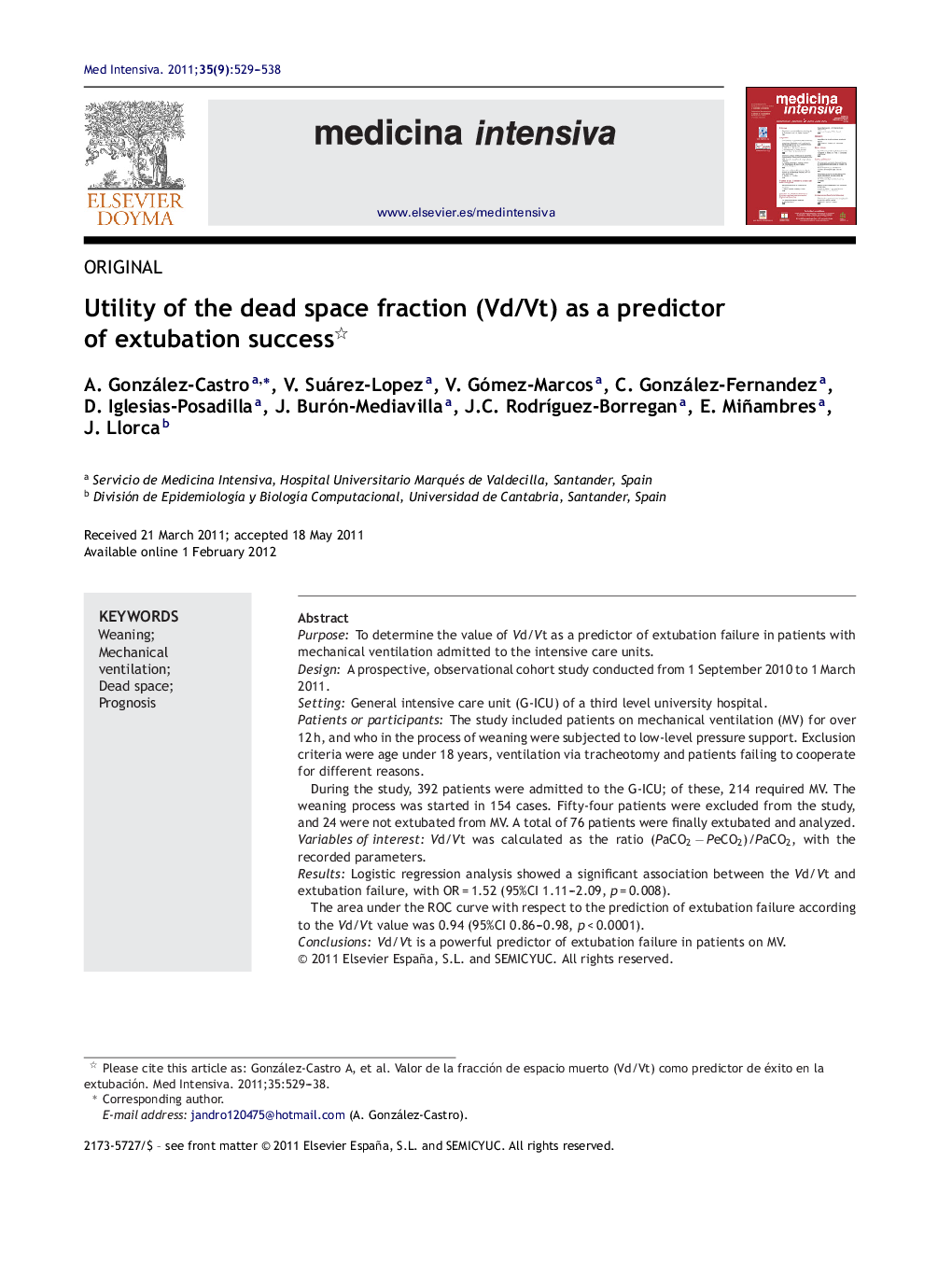| Article ID | Journal | Published Year | Pages | File Type |
|---|---|---|---|---|
| 3114300 | Medicina Intensiva (English Edition) | 2011 | 10 Pages |
PurposeTo determine the value of Vd/Vt as a predictor of extubation failure in patients with mechanical ventilation admitted to the intensive care units.DesignA prospective, observational cohort study conducted from 1 September 2010 to 1 March 2011.SettingGeneral intensive care unit (G-ICU) of a third level university hospital.Patients or participantsThe study included patients on mechanical ventilation (MV) for over 12 h, and who in the process of weaning were subjected to low-level pressure support. Exclusion criteria were age under 18 years, ventilation via tracheotomy and patients failing to cooperate for different reasons.During the study, 392 patients were admitted to the G-ICU; of these, 214 required MV. The weaning process was started in 154 cases. Fifty-four patients were excluded from the study, and 24 were not extubated from MV. A total of 76 patients were finally extubated and analyzed.Variables of interestVd/Vt was calculated as the ratio (PaCO2 − PeCO2)/PaCO2, with the recorded parameters.ResultsLogistic regression analysis showed a significant association between the Vd/Vt and extubation failure, with OR = 1.52 (95%CI 1.11–2.09, p = 0.008).The area under the ROC curve with respect to the prediction of extubation failure according to the Vd/Vt value was 0.94 (95%CI 0.86–0.98, p < 0.0001).ConclusionsVd/Vt is a powerful predictor of extubation failure in patients on MV.
ResumenObjetivoComprobar qué valor tiene la fracción de espacio muerto (Vd/Vt) como predictor del fracaso en la extubación de los enfermos que necesitaron ventilación mecánica (VM) ingresados en las unidades de cuidados intensivos.DiseñoEstudio de cohortes, prospectivo, observacional. Desde el 1 de septiembre de 2010 hasta 1 de marzo de 2011.ÁmbitoUnidad de cuidados intensivos generales (UCIG), del complejo hospitalario de tercer nivel Hospital Universitario Marqués de Valdecilla.Pacientes o participantesSe han incluido en el estudio aquellos enfermos que recibían VM por un espacio de tiempo superior a las 12 horas; y quienes en el proceso de destete seguían un protocolo de presión soporte de bajo nivel. Han sido criterios de exclusión la edad inferior a 18 años, enfermos ventilados a través de traqueotomía y enfermos considerados no colaboradores por diversas causas.Durante el periodo de estudio, ingresaron en UCIG 392 enfermos. De ellos 214 precisaron ventilación mecánica. En 154 se inició proceso de destete. Fueron excluidos del estudio 54 enfermos y no fueron extubados de VM 24. Finalmente 76 enfermos fueron extubados y analizados.Variables de interés principalesSe calculó Vd/Vt como el cociente (PaCO2 − Pє CO2)/PaCO2; con los parámetros registrados.ResultadosEl análisis de regresión logística mostró una asociación significativa entre la variable Vd/Vt y el fracaso en la extubación con una OR de 1,52 (IC 95%: 1,11-2,09; p = 0,008). El área bajo la curva ROC, con respecto a predecir el fracaso en la extubación mediante el valor de Vd/Vt fue de 0,94 (IC 95%: 0,86-0,98; p < 0,0001).ConclusionesConsideramos Vd/Vt un potente predictor del fracaso en la extubación de la VM.
